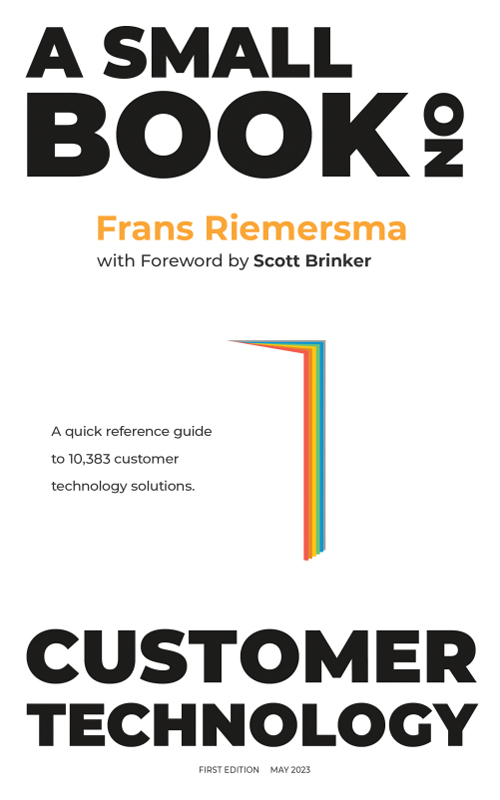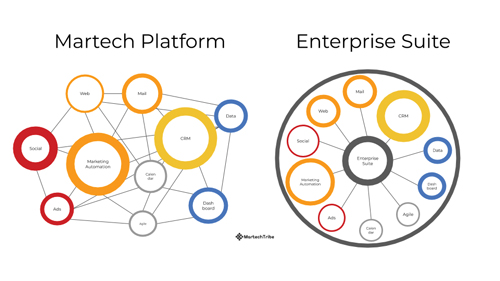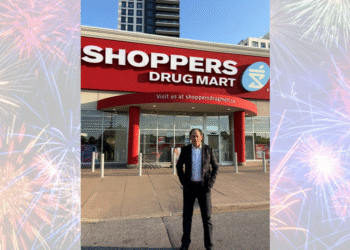Frans Riemersma is the Founder of the marketing technology consultancy Martech Tribe, author of “A Small Book on Customer Technology”, and the co-producer of the “State of Martech Report”.
 The story of marketing automation over the past three decades or so has largely been one of rapid adaptation to technological change.
The story of marketing automation over the past three decades or so has largely been one of rapid adaptation to technological change.
With each defining era of technology – whether it was the launch of the Web and email in the early 1990s, the mass adoption of smartphones and social media platforms through the mid-2000s, or the transition to cloud computing and software-as-a service in the 2010s — new MarTech solutions always emerged to make it easier for brands to connect with people across channels. As channels multiplied, so did the need for more and more specialized apps.
Today the industry is facing a new era of technological change unlike anything that has come before it. Ever since ChatGPT was unveiled in 2022, the pace of innovation has been frantic. Almost overnight it seemed generative AI was being embedded into every software platform and tool. All of the established MarTech providers rushed to make AI a standard feature of their platforms. And lately a swarm of AI-native startups have jumped aboard, changing the contours of the MarTech landscape.
Today all parts of the marketing value chain – from ideation to design to content creation to channel activation to measurement — is being transformed. And no sooner have marketers begun to wrap their heads around this first ferocious wave of AI-led innovation when along comes an even more disruptive force: agentic AI which will upend how marketers actually go about their work.
We’ve certainly come a long way from just over a decade or so ago when email software applications (like ExactTarget or Eloqua) and programmatic ad platforms (like The Trade Desk) were the go-to MarTech tools of performance marketers. Back then marketers felt proud of themselves just for pulling off a multi-channel campaign, incorporating email, social media, and maybe mobile messaging.
With the shift in marketing strategy from flooding inboxes with promotional email to anywhere-anytime personalized engagement, the “marchitecture” has kept expanding to accommodate new forms of connectivity. MarTech stacks have grown to become a motley assortment of “best-of-breed” point solutions, all with their own databases, using APIs to shuttle data back and forth. Even the bundled marketing automation and CRM suites still struggle to fully integrate their closed systems with external apps, forcing marketers to use middleware (like Zapier) to automate their workflows. In fact, the number one problem facing the marketing operations group in charge of the infrastructure is integration. Too many data siloes, too many apps, too many interfaces, too many overlapping and conflicting workflow rules — too many chances for something to go wrong.
 Today the entire constellation of MarTech solutions across all categories has swollen to more than 15 thousand vendors (up from a paltry 150 in 2011), according to the latest “State of MarTech” report, produced by industry thought leaders Scott Brinker and Frans Riemersma. Much of the past year’s growth in this ever expanding universe is attributable to the AI-centric start-ups.
Today the entire constellation of MarTech solutions across all categories has swollen to more than 15 thousand vendors (up from a paltry 150 in 2011), according to the latest “State of MarTech” report, produced by industry thought leaders Scott Brinker and Frans Riemersma. Much of the past year’s growth in this ever expanding universe is attributable to the AI-centric start-ups.
As Scott and Frans say, the market is “insanely crowded”. And it is likely to keep growing, maybe at an even faster pace, as businesses ramp up their spending on marketing automation from 20 percent of the marketing budget today to 31 percent over the next five years1. But the MarTech stack of the past — a bunch of niche applications loosely bolted to a central marketing automation or CRM platform — will slowly give way to a more “composable” ecosystem of interoperable software components, orchestrated on the back end through AI agents. Hard to say what that marchitecture might look like exactly, other than a unified customer data layer at the center, but certainly it promises to be more streamlined, efficient and less siloed than now.
Frans Riemersma figures that ownership of this complex MarTech ecosystem might eventually be transferred from marketing ops to IT because the entire infrastructure will be deemed too important to be left in the hands of marketers due to security and compliance risks. Marketing’s job at that point? Spend more time thinking about the customer experience and less about getting the next campaign out the door.
Stephen Shaw: What’s the origin story behind your consultancy?
Frans Riemersma: I was working as the VP R&D for a German MarTech vendor, now called Uptempo2, and I wanted to broaden my horizon. So what I did was start looking at the MarTech Landscape of Scott Brinker3 and just started clicking logos. At the time there were not a lot of European vendors on the map. So I started collecting data on what was out there. I think in 2 to 3 years time I added two to three thousand tools to the landscape, just from Europe. So I shipped the data over in an Excel spreadsheet to Scott on a LinkedIn direct message. He asked me how I did it and I started to explain how I set up my MarTech data warehouse. He said maybe we could do this together.
I’d been doing a lot of software selection in the MRM (marketing resource management) space and DAM (digital asset management) space. But you really need to know whether the tools work well together. That was my trigger to start collecting, not just information on the types of tools, but the typical sets of tools in a stack. Is a stack a set of tools or maybe it’s a set of buttons which happen to sit in different tools? Because you never really use an entire tool. I mean it’s just like playing the piano, you don’t hit all the keys all the time. So you are looking for those buttons that really make a difference. And that led me to another database I started to build which was all about RFIs, RFPs. I collected a vast body of requirements, over a thousand. And that gave big insights into what specific industries are using and need in terms of tools and capabilities.
SHAW: I know that the MarTech tool selection process can be pretty bewildering – I’ve been through it a few times in my career.
RIEMERSMA: Yes, indeed. It is not so much about having the best tool either. You have to know how to operate it. The technology is only as advanced as the person operating it. We are so focused on technology but we forget about the driver, let alone the destination. You don’t need all the features and all the data points and all the integrations — “We need everything!”. No, you don’t need everything. You don’t need that Ferrari — by the way, I love them, love to have one, but that doesn’t mean I need one.
SHAW: Is the typical ask of you then “Help me understand what’s the best stack to build?” Or is it “How do I optimize what I’ve already got?”.
RIEMERSMA: It’s a very interesting question because marketing, marketing ops and IT, they all seem to have a different view on MarTech. IT says the tools need to scale and perform: “We have a truck and it’s working”. But what marketing needs is maybe a motorbike instead. Both have an engine and wheels, but they’re used in a completely different way. So IT, especially when they are reporting to CFOs, is focused on making sure everything works. And they’re absolutely right. But marketing is there for future revenue and that is all about experimentation — so that leads to what we know as “shadow IT4”.
SHAW: What does a typical marketing stack looks like? How many moving parts are there? What are the main parts of the engine, to borrow your metaphor? What’s at the center of the stack?
RIEMERSMA: Stacks behave like solar systems. There is usually a hub – the “sun” if you will – defined as having more than 50 percent of all the other tools integrated with it. And that’s different between B2B and B2C. We see in B2B it’s mainly CRM and marketing automation/engagement platforms, as opposed to B2C where it’s more often a cloud data warehouse and CDP [Customer Data Platform]. That’s because in B2B you sell to buying committees so you have a few contacts you need to know a lot about. Whereas in B2C, you need to know a bit about a lot of people.
SHAW: In the past a lot of the CRM and marketing applications stored their own version of the data. So you had all of these disconnected islands of data. Are you seeing applications now pulling data directly from the cloud data warehouse?
RIEMERSMA: Yes is the short answer. Now in the past CDPs have typically been owned by marketing, almost as a way of saying to IT: “We need customer data. And if you can’t provide it, we’ll make a copy of it”. Now in our recent report5 that Scott Brinker and myself published, we saw that CDPs are becoming less the center of the stack. Much less. Especially in B2C, where it went from number one to number four. We had a conversation with David Raab6 and he was on the money when he told us, “Listen, CDPs are not going away, but their functions are being redistributed.” So to your point, yes, the cloud data warehouse becomes more and more important as customer data becomes more important to companies.
SHAW: I think I read at one point, this is a few years ago, that there were minimum of 17 different applications in a typical marketing stack.
RIEMERSMA: So in company stacks they’re easily a couple of hundred. In my marketing stack data warehouse we see on average between 30-40 but that’s the tip of the iceberg. With some clients it can be double that due to redundancy. Sometimes you have two systems that do the same thing. We found that 82% of companies maintain duplicate applications on purpose before moving one of them over to the main stack.
SHAW: When you’re doing an assessment of a company’s marketing stack, what kinds of things are you looking for specifically to optimize?
RIEMERSMA: It depends on which of the three buying groups approach me, namely marketing, marketing ops, or IT. IT wants something scalable and secure whereas marketing is always on the lookout for new technology, i.e. influencers or loyalty or attribution or what have you. Marketing ops is normally the smallest team and they are looking to optimize the main platform, just making sure the nuts and bolts are working and they can at least deliver the minimum required automation flows and support the new tactics and campaigns. Each group really has different requirements and priorities depending on their roles and responsibilities.
SHAW: The knock on these “frankenstacks” is that they go underutilized.
RIEMERSMA: The word “utilization”, frankly I don’t understand it, I don’t know what it means. If I’m behind the wheel of a car, am I driving it well enough? Who cares? Where are you going? Very often the core customer journeys, like replacing your credit card, updating your subscription, is not even well designed. Why don’t we have our basics in place? And why do we focus so much on generating new leads while the current customers have a suboptimal experience?
SHAW: In terms of how you manage the stack, who should be in charge? Is that a cross functional team? Is it just marketing ops? What should the optimal organizational structure be?
RIEMERSMA: The optimal ones – and those are rare – are the cross functional teams. But I think marketing ops is best equipped because they are both tech and business savvy while marketers are business savvy, IT is tech savvy, and so they bridge the gap. I really like what Scott Vaughan, former CMO from Integrate7 said: that marketing ops done in a good way is telling the customer story at the boardroom table.
SHAW: On average around 20 percent of the marketing budget is being spent on MarTech and now companies are thinking of spending upwards of 40 percent. What are you seeing and who should control the purse strings?
RIEMERSMA: Yeah, this is a very good question. I’m a big fan of follow the money, because then you know who’s calling the shots. But the allocation has grown organically for two good reasons: one is protecting revenue, the other is creating new revenue.
SHAW: In your latest report you state that MarTech has reached a tipping point. What do you mean?
RIEMERSMA: AI is changing the game. Software helps humans execute a task. We’re the plumbers. But now AI executes the task on behalf of us. So that is a game changer. And now suddenly we are no longer plumbers, we are maybe choreographers. And that is, for me, a tipping point. Now you don’t have to think about a tool or certain features. You just work with an AI agent to complete a certain task. Some people call it “micro SaaS”. That’s why I think it’s a tipping point. The dynamics are going to change.
SHAW: It’s a massive paradigm shift – it’s not just flipping a switch.
RIEMERSMA: In my mind, it’s almost like switching from silent movies to sound. So we’re still in a very early age of generative AI. And I think this is also a movement towards customer first, rather than technology or marketing first.
SHAW: Let’s talk about the latest MarTech report. There are 15,384 solutions in the market. What are some of the changes that have occurred that are driving this exponential market growth?
RIEMERSMA: Human creativity combined with software costs coming down. That’s the short answer. Often we hear people say that so many tools can’t be good, there has to be consolidation. Only the quality products should survive. But in producing our report, we look at G2 ratings8. A lot of the tools that went out of business – 1,200 in the last year – had a rating of 4 or higher in a scale of 5. I’m not trying to put as many logos as I can on the landscape, I’m not making up logos. It’s what we find, it’s what we see. These companies want to outperform each other and deliver the best product possible to marketing people. Like, in Amsterdam, we have a lot of restaurants here. Nobody complains about too many restaurants. Can’t we just have McDonald’s and Chinese food? No! Variety is a good thing.
SHAW: What are the categories that you’re seeing the fastest growth in? I know product management was a big one.
RIEMERSMA: There are six categories in the landscape and 49 sub-categories. Everything on the Landscape has a price tag, has a demo, has a subscription page or a login. But there’s many tools that you don’t see that fill in the gaps to make sure that a unique customer experience is possible. If you look at all the tools out there — those 15,000 or so — how often do they show up in stacks? We looked at not only product management, but also at integration platforms, at mobile apps, CMS even, and those four categories are all booming — even CMS [Content Management System] which is already at 70 percent prevalence. But product management outperformed by far all the other 49 categories. These product management lifecycle tools are really focused on supporting and building software.
SHAW: Maybe you can help me understand this idea of composable marketing stacks.
RIEMERSMA: I can give you one word and you will understand what it means: Lego. It’s just like Lego blocks. Software is always built out of plugins, components, libraries, classes, objects. It’s composable by nature. You can plug and play.
SHAW: I think of a platform like HubSpot which has all of these APIs linked to hundreds of applications that fill a particular function of some kind. Is that what we’re talking about? Or is it that HubSpot has natively constituent features which you can plug in or not?
RIEMERSMA: HubSpot is a particularly good example because what they do is integrate with a lot of other parties natively. Or they integrate with tools like Zapier and Make.com9. So you need to be able to integrate. And this is why the likes of Zapier is so successful. What suites have been trying to deliver is that they are basically a stack to go. So you have multiple modules, all supposedly integrated, and that comes with a lot of costs because you need to buy a lot of modules. And these integrations from big platforms are not always a guarantee for success. So then maybe it’s better to integrate through a third party platform.
SHAW: MarTech is in this transitional state as you stated earlier. In marketing, what are some of the more common use cases that are really driving the business case for AI adoption? I think about Jasper10 with content creation being an obvious one. Chatbots clearly. Automated workflows.
RIEMERSMA: I try to keep it simple. There are two avenues where AI makes it’s way into companies, “outside in” and “inside out”. So “outside in” is generative AI based tools. You might call it “indie tools”, just hacked and stacked together and then commercialized. The other one is through embedded automated workflows in your Eloqua, your Marketo, your HubSpot or what have you. And then of course there’s a completely different avenue – I call it “inside out” where we’re using AI assistants, co-pilots, AI workflows, AI agents, and now MCP integration.
SHAW: Explain MCP to me.
RIEMERSMA: MCP is a protocol that helps you integrate different tools. So AI agents are separate from any other tools, mainly predefined, and they can look stuff up online. Now you want to natively integrate those agents to certain other tools, like HubSpot. Well, that is where you use MCP.
SHAW: Is it a means of orchestrating across the different agents?
RIEMERSMA: Yeah, it’s integration. And so in essence, you can now build your own platform. The only limitation is your imagination. And that is something else. I have seen a growth hacker that created a tool with AI, one or two days, made $150,000 in that month. This is the new normal.
SHAW: With respect to the MarTech function, do you foresee an eventual absorption into the IT group because of the importance now of data and CX?
RIEMERSMA: Yeah. This is a new digital transformation wave where AI executes agentically for us. I don’t have a crystal ball, so I don’t know where it’s headed, but we do need guardrails and oversight. That involves of course governance and privacy. So who should manage AI and that technology? I think we have to work together as IT, marketing ops, and marketing to make that happen.
SHAW: What’s the headline going to be on your next report, do you think?
RIEMERSMA: Oh, that’s a very difficult question. But software costs are coming down. And with AI replacing the tough work, the stuff that makes you face your customer with your back and not with your face, I think a lot of the technology burdens have been removed. So now it’s all about being experience led. Do you understand what the customer really wants? So I think being experience led is maybe one of the most important things for us to focus on. In many conversations we’re so technology focused. What tool should I have? What type of features? Do we need the latest, greatest? I’m not sure how much longer that conversation will be needed.
- The CMO Survey, Fall 2024.
- Uptempo is a martech vendor specializing in marketing operations and resource management (MRM) solutions.
- Scott Brinker’s Marketing Technology Landscape Supergraphic visually depicts the landscape of MarTech solutions.
- “Shadow IT” refers to the unauthorized use of technology within an organization.
- “The State of MarTech Report”, 2025
- David Raab is Founder of the Customer Data Platform Institute.
- Scott Vaughan is a well known marketing advisor and consultant.
- A G2 Score is a standardized metric used to rank products and vendors.
- Zapier is a tool that helps automate repetitive tasks between two or more apps without coding. Make is a no-code automation platform that allows users to connect apps and services to automate workflows and tasks.
- Jasper is an AI-powered software platform designed to help marketers create content.
Stephen Shaw is the Chief Strategy Officer of Kenna, a marketing solutions provider specializing in delivering a more unified customer experience. He is also the host of the Customer First Thinking podcast. Stephen can be reached via e-mail at sshaw@kenna.ca


















